Big developed market central banks are shifting their strategies amid increasing uncertainty in global economics and politics.
Of the five central banks that convened this week, only Switzerland's central bank enacted a cut, while traders anticipate further easing in the United States and Britain, with Japan continuing to adopt a rate-hiking stance.
Here's an overview of the current status of ten major central banks:
Switzerland's central bank cut interest rates by 25 basis points (bps) to 0.25%, marking the fifth consecutive reduction since it began lowering rates from 1.75% a year ago. Markets do not expect further cuts, which is significant since the Swiss National Bank has been the most dovish among developed market central banks, although policymakers have not ruled out additional adjustments.
The Bank of Canada lowered its key interest rate by 25 bps to 2.75% last week, reflecting its seventh successive reduction. The Bank plans to "proceed carefully with any further changes" due to concerns about inflationary pressures and weaker growth. Economists suggest that the risk of a tariff-induced slowdown will keep the BoC in an easing mode, with markets pricing in nearly two more 25 bps rate cuts by year-end.
The Swedish Riksbank opted to keep rates steady at 2.25% and indicated it would maintain that level for now. While the Riksbank has been dovish, cutting rates from 4% to stimulate a sluggish economy, inflation remains above its 2% target, leading markets to agree that further cuts are not likely.
The Reserve Bank of New Zealand recently reduced the official cash rate by half a point to 3.75%, following a total reduction of 175 bps over the past seven months. RBNZ Governor Adrian Orr has indicated potential further cuts of 25 bps in April and May, aiming to position rates within a neutral range, with market expectations aligned accordingly.
The European Central Bank lowered rates earlier this month to 2.5% as part of its sixth cut since June. However, the ECB cautioned about uncertainties, including the risk of rising inflation due to trade tensions and increased defense spending. Policymakers are considering a pause in easing in April before potentially lowering rates again.
The Federal Reserve maintained steady rates on Wednesday, projecting two additional cuts for the year while noting "unusually elevated" uncertainty. Chairman Jerome Powell remarked that President Trump's trade policies have contributed to slower growth and temporarily higher inflation.
The Bank of England held interest rates steady at 4.5%, signaling a gradual decline but committing to closely monitor global and domestic economic developments. With inflation consistently above its 2% target, the BoE has taken a more cautious approach than many of its peers, cutting rates by 75 basis points since it began easing in mid-2024, with markets expecting two further 25 basis point cuts this year.
The Reserve Bank of Australia cut rates in February for the first time this cycle, driven primarily by the concern of maintaining overly tight policies for too long. Despite a strong labor market, which makes the RBA cautious about further easing, market expectations also include two more rate cuts this year.
Norway's central bank has held rates steady since late 2023 but indicated in February that it is "approaching the time when we can ease monetary policy a little." Market expectations do not foresee a cut until at least June, with attention on the Norges Bank's meeting on March 27 for updates to its rate projections.
Japan remains a notable outlier in a rate-hiking cycle; however, it too opted to keep rates steady on Wednesday, suggesting that ongoing inflation concerns necessitate further tightening, with markets pricing in at least one 25 bps increase by year-end. Governor Kazuo Ueda cautioned about escalating global economic uncertainty, indicating that the timing of future hikes will be influenced by the repercussions of U.S. tariff policies.
